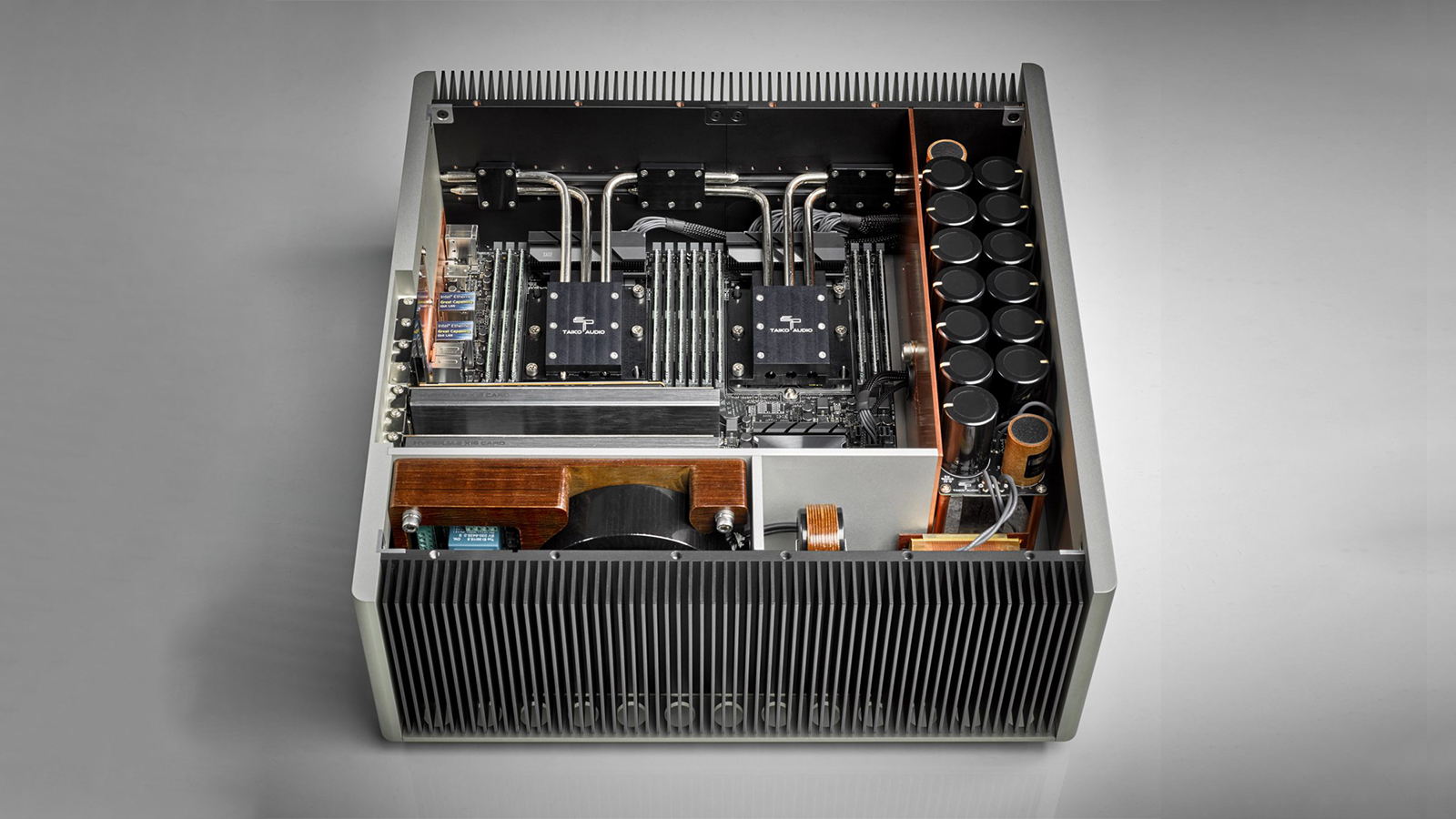Fanless audiophile PC sells for close to $30,000 — music server features dual Xeon 10-core CPUs, 48GB RAM, 280GB Optane SSD, and 2TB secondary storage expandable to 24TB

Dutch high-end audio company Taiko Audio sells a fanless music server designed for the most dedicated audiophile. The Taiko Audio Extreme Server, which FanlessTech shared on X (formerly Twitter), is intended to store lossless audio files and stream music from services like Tidal. It starts at €28,000 or over US$29,600 with 2TB of storage. Its other specifications include two Intel Xeon Scalable 10-core CPUs and a custom, entirely passive cooling system, ensuring your listening pleasure isn’t disturbed by fan noise and airflow.
Taiko’s approach of using two processors allows the Extreme Server to use dedicated servers for specific processes—one for running the user interface (which is still based on a custom Windows 10 Enterprise LTSC 2019 operating system) and one for exclusively running the Roon music management app. According to the company, “The choice to design a dual CPU system was largely fueled by finding a way around the impact Roon’s luxury interface has on sound quality. It does enable Roon processing to become virtually inaudible, a world’s first in our experience.”
Aside from this, the other specifications of the Extreme Server include a 280 GB SSD for the operating system and a base storage capacity of 2 TB for your music files, which you can expand up to 64 TB (but will cost you an additional €1,855 or more than $1,960). It’s also equipped with 48GB of RAM, which, amazingly, is divided into twelve 4GB custom-made industrial memory modules. Taiko says that “fewer and lower speed DIMMs are better for sound quality,” which is why it didn’t use the best RAM for gaming.
Who buys €28,000 fanless music server exactly? https://t.co/buwXaiKkCV pic.twitter.com/at5z3PvWgDDecember 9, 2024
Of course, we cannot forget about the specialized power supply that ensures the best sound quality. It also includes multiple audio and peripheral connections, including five USB ports, two copper Ethernet ports, a fiber SFP open slot Ethernet port, a VGA port, a S/PDIF port, and a single AES/EBU port (which is optionally available in dual or quad setups).
This isn’t the only audiophile server to come on the market, with the $3,699 Nucleus Titan audiophile media server—powered by a standard NUC—arriving to market early this year, and the $1,795 Undentia Cirrus7-SE music server has been available since 2021. However, the Taiko Audio Extreme Server takes an audiophile music server's performance (and price) to the extreme. These unbelievable prices align with other audiophile equipment we find in the market. While many of these specialized devices do have an extra layer of care and research, which could justify their hefty costs, some other devices, like the LAN iSilencer, Innuos Phoenix audiophile network switch, and this ‘audiophile’ SSD, are just dubious snake-oil equipment.
The two Intel Xeon processors and the custom cooling solution will make the Extreme Server more expensive than your average gaming PC. But we wonder: does the eight-fold price increase between Nucleus Titan and the Extreme Server deliver an eight-fold jump in sound quality?
Get Tom's Hardware's best news and in-depth reviews, straight to your inbox.

Jowi Morales is a tech enthusiast with years of experience working in the industry. He’s been writing with several tech publications since 2021, where he’s been interested in tech hardware and consumer electronics.
-
gg83 I love this stuff. Hobbies do cost a lot of money. Audio has to be unique in that sense. Fixing and modding a car has visible results. Audio is 100 subjective.Reply -
why_wolf a fool and their money is soon parted. Just pure snake oil.Reply
I'm amazed they didn't gold plate the connectors like so many Best Buy cables. -
bit_user A modern A/V Receiver strikes me as oddly resembling a fanless audiophile PC and most cost quite a bit less. They're mixed-signal (handling both analog and digital) and the ones I've seen inside of even have a backplane with cards plugged into a sort of motherboard.Reply -
why_wolf Reply
The thing is you still need an A/V Receiver with this "server". It has no ability to natively power any speakers.bit_user said:A modern A/V Receiver strikes me as oddly resembling a fanless audiophile PC and most cost quite a bit less. They're mixed-signal (handling both analog and digital) and the ones I've seen inside of even have a backplane with cards plugged into a sort of motherboard. -
DougMcC Reply
You could measure the audio output with a pretty trivial microphone setup, and prove to yourself that this is a pure waste of money.gg83 said:I love this stuff. Hobbies do cost a lot of money. Audio has to be unique in that sense. Fixing and modding a car has visible results. Audio is 100 subjective. -
vanadiel007 Taiko says that “fewer and lower speed DIMMs are better for sound quality”.Reply
Would love for Taiko to provide the technical data behind that claim. Have a feeling there is none. -
stonecarver Off there web site, it still needs a DAC. No RCA out's. Nice looking but to far out there in left field for my reality.Reply
https://taikoaudio.com/taiko-2020/reviews/taiko-audio-extreme-music-server-platforms-artesania-exoteryc-and-finite-elemente-pagode-mr/
https://taikoaudio.com/taiko-2020/wp-content/uploads/2024/12/210203-Taiko-Audio-Extreme-Manual_v00_17.x80569.pdf
One of the Extreme’s goals is to provide the least possible latency to the signal processing, therefore, its operating system (based on Windows 10) has been stripped to the core, and the data output is “bit perfect” without any oversampling or upsampling. The latter is not necessary anyway, for a DAC that connects to the Taiko server may or may not employ further data processing; this way the DAC choice is yours. -
UnforcedERROR Reply
You wouldn't want to measure it that way. Microphones are useful for testing speakers/headphones, but not the output of the audio equipment. You'd use an analyzer in this case, since you're going to be more concerned with the distortion measurements. EDIT: this isn't even a DAC-level device, its entire purpose is to output to a DAC, which makes measuring it even more irrelevant and the cost even more absurd.DougMcC said:You could measure the audio output with a pretty trivial microphone setup, and prove to yourself that this is a pure waste of money.
Still, this is pure marketing garbage. Audiophile stuff is always ridiculous, but some of the upper-range items are designed specifically for people with plenty of money and no understanding of what they're purchasing. -
DougMcC Reply
Meh. Expensive compared to a couple of mics. The mics will tell you all you need to know.UnforcedERROR said:You wouldn't want to measure it that way. Microphones are useful for testing speakers/headphones, but not the output of the audio equipment. You'd use an analyzer in this case, since you're going to be more concerned with the distortion measurements. EDIT: this isn't even a DAC-level device, its entire purpose is to output to a DAC, which makes measuring it even more irrelevant and the cost even more absurd.
Still, this is pure marketing garbage. Audiophile stuff is always ridiculous, but some of the upper-range items are designed specifically for people with plenty of money and no understanding of what they're purchasing. -
bit_user Reply
Oh, yeah. I hadn't noticed this thing doesn't even seem to have any analog outputs? SMH.why_wolf said:The thing is you still need an A/V Receiver with this "server". It has no ability to natively power any speakers.
My home PC setup has long consisted of using digital outputs, feeding into a Toslink crossbar switch -> standalone DAC -> preamp -> powered speakers. I also had a standalone heaphone amp connected to the tape loop of the preamp, but its volume knob got scratchy and the headphone output on the preamp is really pretty good.
The DAC -> preamp -> powered speakers are connected via balanced interconnects, which is the only kind to use if you're really serious about sound quality. The speakers are legit studio monitors perched on stands and placed at ear-level and with my head on-axis, since distortion tends to increase the farther off-axis you go.
These days, most of my listening happens on noise cancelling Sony headphones, using their LDAC codec. If there's any background noise at all, the noise cancelling headphones easily surpass the quality of my PC audio system, even with hi fi headphones.
If I wanted to level-up my speaker setup, the next thing I'd do is parametric equalization to defeat the resonances in my room.